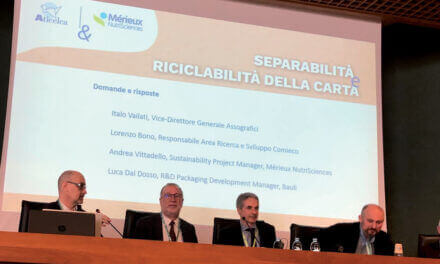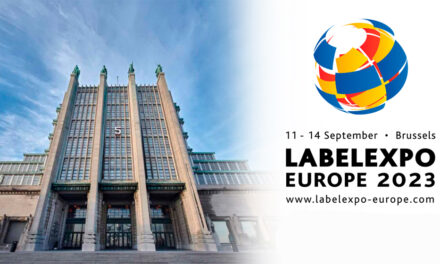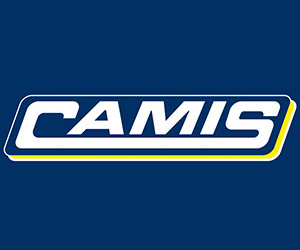 Andrea Briganti, director of the association of Italian manufacturers of machines for graphic arts and packaging converting, director of the Confindustria Paper and Printing Federation and entrepreneur himself, takes stock of the sector in 2020 and analyzes market prospects and trends. Figures, objectives and reflections in view of the renaissance.
Andrea Briganti, director of the association of Italian manufacturers of machines for graphic arts and packaging converting, director of the Confindustria Paper and Printing Federation and entrepreneur himself, takes stock of the sector in 2020 and analyzes market prospects and trends. Figures, objectives and reflections in view of the renaissance.
How was the year that just ended for Italian manufacturers of machinery for the graphic arts, paper, converting and related industries?
In 2020, the machine manufacturers’ sector saw a 16.7% drop in turnover compared to 2019 (a year in which it had closed at -1.6%, essentially in line with 2018), settling at a value of 2 billion 360 million euros. This figure, however, does not take into account the block in deliveries caused by lockdowns and therefore the value of the machines left in stock; in the given situation, therefore, it is more significant to consider the value of production, which certainly had a more limited decline. The drop of -20.2% recorded in deliveries confirms this.
Exports account for almost all the losses, with a drop in turnover of 14.4%, or 8.6% compared to the previous two-year period. This clarification is important because, putting the production capacity of companies at a 100, in 2019 we registered a strong return of domestic demand supported by the 4.0 incentives, a dynamic that reoriented production on Italy. Let’s not forget, in fact, that to make a machine it takes on average 8 months from the formalization of the order and therefore – notwithstanding structural investments – within a year the output of a manufacturer is only restricted to programmed machines.
As far as imports are concerned, they too were obviously affected by the slowdown in international flows and registered a loss of 13.6% against apparent consumption of 18.1%.
How much did the pandemic weigh on you, how did companies react and what is the state of health of printing press manufacturers in Italy?
As Acimga we have contributed, through the lobbying actions carried out by the Italian Paper and Graphics Federation, to maintaining the operational and productive continuity of the Ateco codes concerning converting and printing machinery. Indeed, despite the fact that from one day to the next this second category of equipment was expunged from the definitive list – by the Council of Ministers, continuity has been guaranteed by the certifications of direct customers, i.e. printers.
Companies have reacted very strongly to the emergency, in some cases (few) resorting to redundancy funds and, above all, restructuring the mix of products and services. In fact, many operators have seized the opportunity to rethink their production processes and, above all, their supply model in the light of the two major drivers that indicate the prospect: servitization and sustainability represent the future even for companies that are essentially engineering companies like our own.
What are the forecasts for 2021?
The orders indicator to date is very positive and forecasts an increase in turnover that by the end of the year could compensate for much of 2020’s losses. Although it is too early to make forecasts, given the gradual stabilization of the Covid emergency, we expect to quickly return to the levels of the end of 2019.
What does the industry expect from the new government and the Recovery Plan?
As Acimga and the Italian Paper and Graphics Federation, we are working hard on the Recovery Plan together with our lobbying firm. Given the strategic framework of the European recovery program, what we are waiting for is funding to support 4.0 technology, especially if it is linked to the energy transition, and tax exemption policies for investments made with a view to digitalizing production processes and having a positive environmental impact.
What are the market trends, from the subject of investments (also for Industry 4.0) to the types of machines most in demand?
Going back to the previous answer, the market is asking for technologies able to transform data into information and to multiply the interconnection between different spots, lines and company functions – typically, to remotely manage the after-sales service and have predictive tools at the service of production. In fact, technology manufacturers will play an increasingly important role as consultants, supporting printers on the terrain of production efficiency and predictive maintenance.
As far as demand trends are concerned, there is great interest in new generation printing presses but also in converting technologies, especially for corrugated cardboard.
How do you see the possibility of aggregations or alliances between companies in the sector in order to be bigger and more competitive?
In principle, I do not believe that size is a key element of competitive advantage. What counts is rather the ability to respond flexibly and quickly to market changes, as well as to serve customers by guaranteeing continuity and proximity. Once again, service is the key. And the breadth of the offer: the customer must be able to offer everything he needs – technology and proximity – to manage the entire printing process. The large companies that have already structured a wide and complete offer are “cashing in” on a very strong competitive advantage.
How and how much is the presence on international markets important?
It is decisive! Italian manufacturers export an average of 60% of their output and last year, in the conditions we know, one machine out of two was sold abroad. Therefore, it’s essential to effectively preside over both European and non-European markets: USA and China in the first place and India in the future.
What are the main technological innovations underway and expected also from the point of view of environmental sustainability?
There is certainly a lot of work being done today on inks, waste management and, in general, on chemicals in various ways linked to the printing process. These elements will make a difference in terms of competitive advantage and environmental impact, along with consulting and support services, for example on green transition.
What does the industry expect from the next Drupa in virtual format in April 2021, and how much does the postponement of the actual Drupa to 2024 weigh?
At this time it is still unclear what kind of format the virtual edition of drupa will take, so there are no great expectations. It could be the event that marks the future of digital fairs or a moment of sharing among many. I would like to point out, for example, the Print4All conference that we organized last June with a truly sieable response at an international level, and that we will propose again this June 2021 under the name of Future Factory.
The postponement of the “real” drupa weighs heavily because companies have made investments in R&D to be able to present new products at the German fair. However, it weighs a little less because postponing the expo allows us to give a little breathing space to lackluster income statements and cash flows, reallocating part of the resources to other promotional activities.
The postponement of “in person” drupa to 2024 supports the Print4All project: the Italian printing and converting fair will take place in 2022, filling an exhibition gap and playing an important role at international level.













